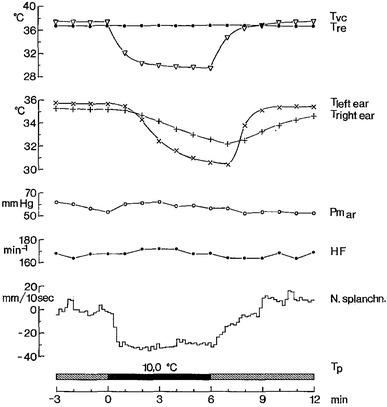Fig. 2.

Results obtained during cold stimulation of deep-body thermosensors in the spinal cord of a rabbit 4 days after spinal transection at C6, i.e., below the origin of the phrenic nerve. The thoracic section of the vertebral canal was cooled by means of a water-perfused thermode tube inserted into the thoracic peridural space. T p water temperature at the entrance into the thermode during cooling (black bar). The anesthetized animal was kept in a warm-thermoneutral environment and artificially ventilated under neuromuscular blockade which suppressed cold shivering in response to spinal cord cooling [44]. T re deep-body (rectal) temperature, Tvc peridural space temperature, T left ear, T right ear ear skin temperatures as skin blood flow indicator. N splanchn. multi-fiber activity recorded from a splanchnic nerve branch. Postganglionic sympathetic activity is shown as the change of output, relative to average activity level during pre-cooling period, after analog integration of multi-fiber discharge. Cooling of spinal deep-body thermosensors clearly depressed splanchnic sympathetic activity, whereas decreases in ear skin temperature indicated reduced skin blood flow attributable to activation of vasoconstrictor efferents to the ear skin. No distinct changes of arterial pressure (Pm ar) and heart rate (HF). From Walther et al. [82]
